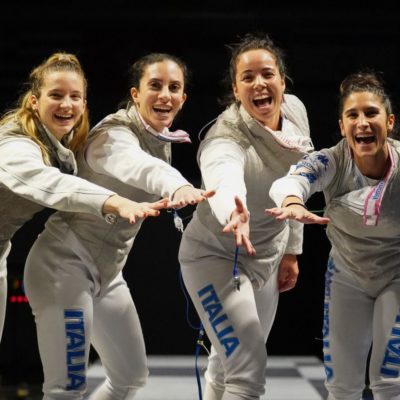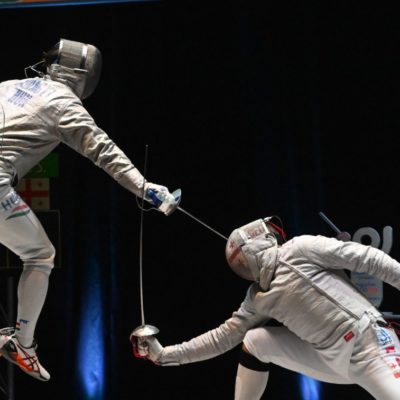Ever see an old action that just doesn’t fit with today’s fencing rules? Well, we’ve got one here that just might make a comeback if the proposed foil fencing rule changes go through. Take a look at this video clip from the 1989 World Championships and read commentary on the action from two Fencing.Net writers.
Watch this video clip, and then read the commentary on the action by Walter and Craig.
Please allow the video to load.
Video Clip Information: 1989 World Championship Team Final
Alexander Romankov (left, Soviet Union) versus Alexander Koch (Federal Republic of Germany)
Note: This is old fencing, so the scoring lights are reversed!
Video clip courtesy of Fencing Footage: http://www.fencingfootage.com/
Walter’s Commentary:
This is a great “oops, I guess you’re dead” sort of action. On the first viewing, I wondered what the director was smoking — and what its street value was in 1989. Even Romankov seemed confused for a moment, fully prepared to take his guard again before the director’s call penetrated. But on future viewings (full speed, and frame-by-frame), it became clear that the director saw everything correctly on the first go-around. Koch’s attack was parried by Romankov. Ignore that white light, it is really a remise.
The action goes: Attack from the right, parry-riposte from the left: touch left. Remise from the right. The action is weird in that the remise lands before the riposte it grammatically follows, but then, that’s what happens sometimes when two people try to shout out a sentence at the same time. In fact, it’s a very clear action except that the fencers are very close together. If they’d had 5 feet between them, it would have been a no-brainer.
Romankov’s riposte is perplexing because it looks like a jab, and moreover he reverses his shoulders to be able to land the point on target. Strictly speaking, today’s Rule t.46 would annul Romankov’s touch… but there might be wiggle room (literally!) with directors who give credence to the sort of “continuous ripostes” used to hit passing flechers, or who imagine that shoulders aren’t reversed so long as the torso is facing a very close opponent.
The bigger, philosophical questions linger: If the remise landed first, why should we ignore it? Would Romankov be able to ignore that remise in a “real” swordfight? Is the concept of Right of Way completely stupid, given this action?
In his book “Fencing: The Modern International Style”, Istvan Lukovich parses Right of Way in a very useful manner. In a real fight, both of these fencers would have been seriously wounded — but it would have been Koch’s fault. Koch knew of the threat, but did nothing about it. Romankov was behaving rationally, Koch wasn’t — and Right of Way is all about moving the chaos of a swordfight into the “realm of reason.” So after his parry, Romankov is not asked to control his opponent’s tip, or even be aware of the opponent’s blade. Romankov has done what he needed to do, and when he’s randomly hit off target by his opponent, that’s an error caused by his opponent, not Romankov. The director knows that Romankov should not be penalized by the German’s white light.
Romankov is much too dignified to contradict the director, and too pragmatic to let the call bother him. Romankov was not accepting a point that wasn’t his — throughout the competition, he routinely gave acknowledgements (that the directors didn’t need, but it was a nice gesture). If Romankov was confused by the call, it would be because he just didn’t know the action, despite his galactic fencing skill. This is why we have directors in the first place — they are more than just eye-candy for our vast television audiences.
Craig’s commentary: Back to the Future?
In this Romankov vs. Koch clip, we see an action that may come back in vogue in 2005 if the restriction against reversing the shoulders is removed. Given the proposed rules change, it’s important to look at some of these actions as most fencers today have never dealt with the actions and most referees haven’t seen these (or saw them a long time ago) and will need to get back up to speed on them.
The action is really simple – it’s a clear parry-riposte for Romankov and remise against Koch. What causes the double-take is the reversal of shoulders. I haven’t had to deal with that action since about a year into my fencing career, so I’ve never incorporated it into high-level bouting.
If the reversal shoulder rule change goes into effect, this will be a viable action again. The key thing to note on a rules basis is that Romankov’s reversal doesn’t cover target (which the FIE rules commission says is the rule that makes the reversal of shoulders restriction unnecessary.)
The shoulder reversal allows Romankov to collapse distance to get the riposte. Currently a fencer either has to execute a prime riposte or have a monster close-distance flick to hit that riposte without expanding the distance more (and giving the attacker more chances to keep closing distance and hitting with a remise).
If the restriction against reversing the shoulders goes away, then fencers will need to learn how to create and take advantage of these close distance riposte situations. The lockout timing changes will encourage the remise in this situation as well, but we’ll have to see what the impact of that is on real world bouting. The key for referees is to be able to distinguish between actions like this one, where the shoulder reversal does not cause covering target, and other situations where it will.
Walter Flaschka is assistant coach at Oxford Fencing in Oxford, Mississippi and was a 4 year starter on New York University’s fencing team competing in men’s foil.
Craig Harkins runs the Fencing.Net Web site and was a 4 year varsity fencer and Men’s Foil team captain at the University of North Carolina.





